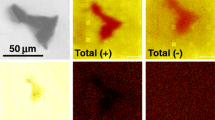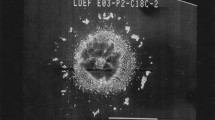Abstract
The ESA mission Rosetta, launched on March 2nd, 2004, carries an instrument suite to the comet 67P/Churyumov-Gerasimenko. The COmetary Secondary Ion Mass Anaylzer – COSIMA – is one of three cometary dust analyzing instruments onboard Rosetta. COSIMA is based on the analytic measurement method of secondary ion mass spectrometry (SIMS). The experiment’s goal is in-situ analysis of the elemental composition (and isotopic composition of key elements) of cometary grains. The chemical characterization will include the main organic components, present homologous and functional groups, as well as the mineralogical and petrographical classification of the inorganic phases. All this analysis is closely related to the chemistry and history of the early solar system. COSIMA covers a mass range from 1 to 3500 amu with a mass resolution m/Δm @ 50% of 2000 at mass 100 amu. Cometary dust is collected on special, metal covered, targets, which are handled by a target manipulation unit. Once exposed to the cometary dust environment, the collected dust grains are located on the target by a microscopic camera. A pulsed primary indium ion beam (among other entities) releases secondary ions from the dust grains. These ions, either positive or negative, are selected and accelerated by electrical fields and travel a well-defined distance through a drift tube and an ion reflector. A microsphere plate with dedicated amplifier is used to detect the ions. The arrival times of the ions are digitized, and the mass spectra of the secondary ions are calculated from these time-of-flight spectra. Through the instrument commissioning, COSIMA took the very first SIMS spectra of the targets in space. COSIMA will be the first instrument applying the SIMS technique in-situ to cometary grain analysis as Rosetta approaches the comet 67P/Churyumov-Gerasimenko, after a long journey of 10 years, in 2014.
Similar content being viewed by others
References
Dahl, D. A.: 1997, INEEL, Idaho Falls, Idaho 83415, DHL@inel.gov: The SIMION software manual (and later versions).
Engrand, C., Kissel, J., Krueger, F. R., Martin, P., Silén, J., Thirkell, L., et al.: Rapid Commun. Mass Spectrom. 20, 1361.
Jessberger, E. K., and Kissel, J.: 1991, In: R. Newburn, M. Neugebauer, and J. Rahe (eds.), Comets in the Post-Halley Era, Springer Verlag, Heidelberg, pp. 1075–1092.
Kissel, J., Sagdeev, R. Z., Bertaux, J. L., Angarov, V. N., Audouze, J., Blamont, J. E., et al.: 1986, NATURE 321 (6067), 280.
Kissel, J., Brownlee, D. E., Bìchler, K., Clark, B. C., Fechtig, H., Grìn, E., et al.: 1986, NATURE (Encounters with Comet Halley –The First Results) 321 (6067), 336.
Kissel, J., and Krueger, F. R.: 1987, NATURE 326, 755.
Krueger, F. R.: A Feasibility Study for CoMA, part 1, Aug. 1988, part 2, Jan. 1989, and part 3, Sept. 1989.
Krueger, F. R., Korth, A., and Kissel, J.: 1991, Space Sci. Rev. 56, 167.
Mamyrin, B. A., Karatyev, V. I., Shmikk, D. V., and Zagulin, V. A.: 1973, Zh Eksp. i Teor. Fiz. 64, 82 or: Sov. Phys. JETP 37(1), July 1973.
Mazets, E. P., Sagdeev, R. Z., Aptekar, R. L., Golenetskii, S. V., Guryan, Yu. A., Dyachkov, A. V., et al.: 1987, Astronomy Astrophys. 187, 699.
McDonnell, J. A. M., Green, S. F., Grìn, E., Kissel, J., Nappo, S., Pankiewicz, G. S., et al.: 1989, Adv. Space Res. 9 (3), 277.
Schwab, M.: 1998, CEMEC GmbH, Obererlbach, FRG: Design of the COSIMA Target Manipulator, (private communication), 1998.
Stephan, T.: 2001, Planet. Space Sci. 49, 859.
Varmuza, K., Werther, W., Krueger, F. R., Kissel, J., and Schmid, E. R.: 1999, Int. J. Mass Spectrom. 189, 79.
Varmuza, K., Kissel, J., Krueger, F. R., and Schmid, E. R.: 2001, In E. Gelpi (Ed.), Advances in Mass Spectrometry, vol. 15 (Wiley & Sons, Chichester), p. 229–246.
Werther, W., Demuth, W., Krueger, F. R., Kissel, J., Schmid, E. R., and Varmuza, K.: 2002, J. Chemom. 16, 99.
Zscheeg, H., Kissel, J., Natour, Gh., and Vollmer, E.: 1992, Astrophs. Space Sci. 195, 447.
Author information
Authors and Affiliations
Corresponding author
Additional information
J. M. Greenberg deceased Nov. 2001
N. G. Utterback deceased Nov. 2003
Rights and permissions
About this article
Cite this article
Kissel, J., Altwegg, K., Clark, B.C. et al. Cosima – High Resolution Time-of-Flight Secondary Ion Mass Spectrometer for the Analysis of Cometary Dust Particles onboard Rosetta. Space Sci Rev 128, 823–867 (2007). https://doi.org/10.1007/s11214-006-9083-0
Received:
Accepted:
Published:
Issue Date:
DOI: https://doi.org/10.1007/s11214-006-9083-0




